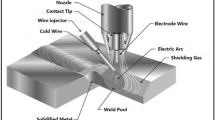Abstract
Carbide-free bainite (CFB) microstructures containing a mixture of nano-sized retained austenite laths and bainitic ferrite exhibit a good combination of strength, ductility, and toughness. In this work, an attempt was made to identify welding electrode compositions with a carbon content of about 0.35 to 0.5 wt.% to achieve carbide-free bainite microstructures in multi-pass shielded metal arc welds. Suitable alloy compositions were designed using a commercial neural network–based database, considering thermodynamic parameters such as allotropic phase boundary (XTo), ΔGɣ-ɑ (driving force for transformation) and martensite start temperatures. Three different alloy compositions were identified using this approach. Shielded metal arc welding (SMAW) electrodes were fabricated with the compositions identified and the samples extracted from the weld deposits were used for dilatometer studies, metallurgical characterisation, and mechanical property evaluation. Based on the results, an optimised electrode composition and welding parameters were identified to stabilise the carbide-free bainitic microstructures in weld metal.






















Similar content being viewed by others
References
Garcia-Mateo C, Caballero FG (2005) Design of carbide free low temperature ultra high strength bainitic steels. ISIJ Int 45:1736
Garcia-Mateo C, Caballero FG, Bhadeshia HKDH (2005) Mechanical properties of low temperature bainite. Mater Sci Forum 500-501:495–502
Garcia-Mateo C, Caballero FG, Sourmail T, Cornide J, Smanio V, Elvira R (2014) Composition design of nanocrystalline bainitic steels by diffusionless solid reaction. Met Mater Int 20(3):405–415
Caballero FG, Santofimia MJ, Capdevila C, García-Mateo C, de Andres CG (2006) Design of advanced bainitic steels by optimisation of TTT diagrams and T0 curves. ISIJ Int 46(10):1479–1488
Caballero FG, Bhadeshia HKDH (2004) Very strong bainite. Curr Opinion Solid State Mater Sci 8:251–257
Bhadeshia HKDH (2016) Prevention of hydrogen embrittlement in steels. ISIJ Int 56:24–36
Szost BA, Vegter RH, Rivera-Diaz-del-Castillo PEJ (2013) Hydrogen-trapping mechanisms in nanostructured steels. Metall Mater Trans A 44A:4542–4550
Alkemade SJ (1996) The weld cracking susceptibility of high hardness armour steel. Australia: Defence Science and Technology Organization. p. 1–14 AR no. 009-659
Madhusudhan Reddy G, Mohandas T, Tagore GRN (1995) Weldability studies on high-strength low-alloy steel using austenitic stainless steel filler. J Mater Process Technol 49:213–228
Bhadeshia HKDH, Lord M, Svensso LE (2003) Silicon rich bainitic steel welds. Joining and welding solutions to industrial problems, JWRI, Osaka University, Osaka, pp 43–52
Fang K, Yang JG, Liu XS, Song KJ, Fang HY, Bhadeshia HKDH (2013) Regeneration technique for welding nanostructured bainite. Mater Des 50:38–43
Krishna murty N, Janaki ram GD, Murty BS, Reddy GM, Rao TJP (2014) Carbide-free bainitic weld metal: a new concept in welding of armor steels. Metall Mater Trans B Process Metall Mater Process Sci 45b:2327
Bhadeshia HKDH The nature, mechanism and properties of strong bainite. Proceedings of the 1st International Symposium on Steel Science (IS3–2007) the Iron and Steel Institute of Japan
Bhadeshia HKDH (2010) Nanostructured bainite. Proc R Soc A 466
Solimon M, Palkowski H (2007) Ultra-fine bainite structure in hypo-eutectoid steels. ISIJ Int 47(12):1703–1710
Garcia-mateo C, Caballero FG, Bhadeshia HKDH (2003) Acceleration of low-temperature bainite. ISIJ Int 43(11):1821–1825
Huang H, Sherif MY, Rivera-Dıaz-del-Castillo PEJ (2013) Combinatorial optimization of carbide-free bainitic nanostructures. Acta Mater 61:1639–1647
Andrews KW (1965) J Iron Steel Inst 203:721–727
Funding
The authors thank the Science and Engineering Research Board (SERB), Department of Science and Technology, Government of India, for funding Extra Mural Research (EMR) (grant EMR/2016/002755) for financially supporting this work.
Author information
Authors and Affiliations
Corresponding author
Additional information
Publisher’s note
Springer Nature remains neutral with regard to jurisdictional claims in published maps and institutional affiliations.
Recommended for publication by Commission II - Arc Welding and Filler Metals
Rights and permissions
About this article
Cite this article
Sundaram, S., Ram, G.D.J. & Amirthalingam, M. Development of shielded metal arc welding electrodes to achieve carbide-free bainitic weld microstructures. Weld World 65, 1–11 (2021). https://doi.org/10.1007/s40194-020-00987-z
Received:
Revised:
Accepted:
Published:
Issue Date:
DOI: https://doi.org/10.1007/s40194-020-00987-z




